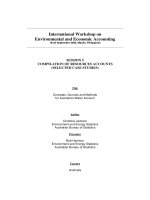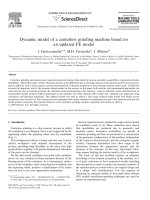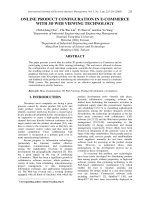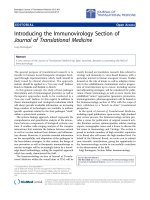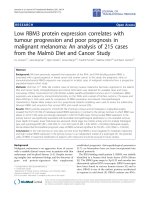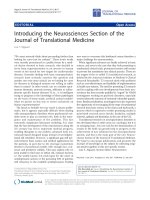Cooney and Cooney International Journal of Emergency Medicine 2011, 4:15 pdf
Bạn đang xem bản rút gọn của tài liệu. Xem và tải ngay bản đầy đủ của tài liệu tại đây (2.3 MB, 6 trang )
CAS E REP O R T Open Access
Massive acute colonic pseudo-obstruction
successfully managed with conservative therapy
in a patient with cerebral palsy
Derek R Cooney
*
and Norma L Cooney
Abstract
Acute colonic pseudo-obstruction (ACPO), also known as Ogilvie syndrome, is a massive dilation of the colon in
the absence of mechanical obstruction. Treatment measures may include anticholinergic agents such as
neostigmine, colonoscopy, or fluoroscopic decompression, surgical decompression, and partial or complete
colectomy. We reviewed the case of a 26-year-old male with cerebral palsy who had a history of chronic
intermittent constipation who presented to the emergency department (ED) with signs of impaction despite
recurrent fleet enemas and oral polyethylene glycol 3350. The patient was found to have a massive colonic
distention of 26 cm likely because of bowel dysmotility, consistent with ACPO. This article includes a discussion of
the literature and images that represent clinical examination, x-ray, and computed tomography (CT) findings of this
patient, who successfully underwent conservative management only. Emergency department detection of this
condition is important, and early intervention may prevent surgical intervention and associated complications.
Background
Acute colonic pseudo-obstruction (ACPO), also known
as Ogilvie syndrome or acute colonic ileus, is a serious
condition that can be relatively easi ly misdiagnosed and
apatient’s presentation ascribedtobothminorcondi-
tions, such as functio nal constipa tion, and major condi-
tions, like mechanical bowel obstruction. It is important
for the emergency physician to be familiar with this
entity and its ma nagement in order to avoid unne ces-
sary morbidity in these cases.
Acute colonic pseudo-obstruction is a distention of
the colon caused by decreased motility in the absence of
mechanical obstruction. ACPO commonly occurs in
association with a severe medical or surgical illness.
Other causes include immobility, medications, electro-
lyte disturbances, and chronic illnesses that dire ctly
affect bowel motility. In an article by Vanek and Al-
Salti, a re view of 393 cases revealed a mean age in the
mid to late 50s, and only 5.5% of patients presented
without a known associated cause [1]. In this study
35.9% of the cases were associated with either a surgical
or obstetrical procedure, and non-operative trauma was
associated with 11.3% of cases. Untreated cases may
result in the development of bowel perforation in up to
15%, resulting in a mortality rate of around 50% [2].
Cerebral palsy has been shown to be associated with a
high rate of chronic constipation. An article by Veugelers
et al. quotes an outpatient incidence as high as 74% in
patients with CP, and there appears to be a neural com-
ponent to the observed colonic dysmotility [3]. In a study
by Johanson et al., neurological disease ca using damage
to the central nervous system was identified as an impor-
tant indepen dent risk factor [4]. These factors could pre-
dispose these patients to development of ACPO.
Symptoms of ACPO include nausea, vomiting, abdom-
inal pain, co nstipation, diarrhea, and fever. Patients with
the complications of ischemic bowel and perforation do
not have significantly different presentation s than thos e
without them [1].
Case presentation
A 26-year-old male with a history of cerebral palsy (CP)
presented to the Emergency Department (ED) with the
complaint of abdominal distension and constipation.
The patient’s mother was present and also the primary
caregiver at home. The patient had a history of chronic
* Correspondence:
Department of Emergency Medicine, SUNY Upstate Medical University,
EMSTAT Center/550 East Genesee, Syracuse, New York 13202, USA
Cooney and Cooney International Journal of Emergency Medicine 2011, 4:15
/>© 2011 Cooney and Co oney; licensee Springer. This is an Open Access article distributed under the t erms of the Creative Commons
Attribution License (http://creativec ommons.o rg/ licenses/by/2.0), which permits unrestricted use, di stribution, and rep roduction in
any me dium, provided the original work is properly cited.
intermittent constipation requiring weekly laxatives and
fleets enemas. On this occasion, despite use of polyethy-
lene glycol 3350 (an osmotic laxative) , multiple enemas,
and an attempt at manual fecal disimpaction by the
mother, the patient had persistent constipation and dis-
comfort. His vital signs were blood pressure: 148/85,
heart rate: 150, respiratory rate: 20, and oxygenation
saturation: 99% on room air, and he was afebrile. On
exam, the patient had a decrease in mental status. His
abdomen was markedly distended and rigid (Figure 1).
Bowel sounds were absent. Laboratory studies showed
no overwhelming abnormalities, with a white blood cell
count of 13,000, creatinine level of 0.7, and potassium
level of 3.7. An acute abdominal series showed a signifi-
cantly distended colon with a 26-cm estimat ed diameter
(Figure 2). CT of the abdomen showed a large amount
of stool and air in the colon without evidence of a
mechanical obstruction, bowel wall thickening, or signs
of perforation (Figures 3, 4 and 5).
The patient was resuscitated in the ED with 2 l nor-
mal saline, and he was given intravenous antibiotics,
piperacillin/tazobactam, to cover enteric bacteria for
concern of impending bowel perforation and probable
current microperforation. A nasogastric (NG) tube was
placed. Gastroenterology and the general surgeon were
immediately consulted. A gastrograffin enema was per-
formed. No evidence of mechanical obstruction was
visualized. As a precaution, the patient was admitted to
the ICU for further management and care. The patient’s
white blood cell count rose to 26,000 on the second
day. With NG tube decompression and multiple enemas,
the patient eventually passed stool and gas. The colonic
distention resolved without pharmacological, endo-
scopic, or surgical interventions. The patient did not
develop worsening signs of sepsis or perforation, and
was discharged in improved and stable condition.
Discussion
The etiology of pseudo-obstruction is not clearly under-
stood. However, it is known that the autonomic nervous
system is the control center for bowel function. The
parasympathetic system innervates the smooth muscle
to induce peristalsis, thereby inducing normal defeca-
tion. Disruption of the parasympathetic system or inner-
vation of the sympathetic system will disrupt normal
bowel function. There are many conditions and inter-
ventions that have been shown to be associated with
bowel dysmotility resulting in ACPO. The differential
diagnoses for this condition should also include
mechanical bowel obstruction, toxic megacolon, and
severe constipation with fecal impaction. In the case
described above, the patient’ s only significant risk fac-
tors for developing ACPO were his CP and overall
chronic disability.
Assessment
X-rays should be obtained immediately for a patient if
one has concern about an obstructive process, especially
Figure 1 Photo demonstrating severe abdominal distention.
Cooney and Cooney International Journal of Emergency Medicine 2011, 4:15
/>Page 2 of 6
Figure 2 X-ray revealing severe colonic dilatation from the pseudo-obstruction with large stool collection.
Figure 3 Axial CT image of the pseudo-obstruction and severely dilated colon.
Cooney and Cooney International Journal of Emergency Medicine 2011, 4:15
/>Page 3 of 6
if the suspicion is high for perforation. An acute abdom-
inal series with an upright chest can provide vital infor-
mation. Free air under the di aphragm indicating bowel
perforation, differential air fluid levels indicating an
ileus, and grossly dilated loops of bowel indicating an
obstructive process can typically be seen and diagnosed
from an x-ray. Additional information can be obtained
from a CT regarding the location of the obstruction
based on the transition zone.
Measurement of the colonic distention has bee n sug-
gested as a potential guide to management and is routi-
nely assessed radiographically. Studies have stated that
dilation of the transverse colon of as little as 9 cm is
potentially dangerous, and patients with cecal diameters
>10-12 cm have been shown to be at higher risk of per-
foration [5-7]. In fact, the study by Vanek and Al-Salti
report ed no perforations for patients with <12 cm cecal
diameter, a 7% perforation and ischemia rate for 12-14
cm, and 23% for patients with >14 cm cecal dilation [1].
However, some studies found no ischemia or perforation
in patients with significant dilation beyond these limits
[8]. Our o wn case reveals a 26-cm dilation of the colon
without evidence of perforation or ischemia. Despite the
massive dilation of the colon, the patient suffered no
significant sequelae. Of additional interest, a retrospec-
tive study by Johnson et al. actually concluded that the
duration of cecal distention may be associated with the
perforation rate, but that the diameter was not. There
may also be a significant difference in perforation risk in
patients with severe colonic dilation with only m oderat e
cecal dilation; however, no such comparison was found
during a review of the literature.
Management
The initial treatment for ACPO includes placement of
a nasogast ric tube, enemas, fluid resuscitation, and
correction of e lectrolyte abnormalities. Antibiotics may
be given to provide some coverage for patients who
Figure 4 Coronal CT image of pseudo-obstruction and severely dilated colon that almost completely fills the view of the abdomen
cavity.
Cooney and Cooney International Journal of Emergency Medicine 2011, 4:15
/>Page 4 of 6
are suspected to have bowel ischemia or perforation
[6]. However, in the study by Vanek and Al-Salti,
there was almost no significa nt difference in symptoms
at presentation between patients with these complica-
tions and t hose without [1], altho ugh they did note
that patients with ischemia and/or pe rforation had a
higher rate of fever (78%) than those that did not
(31%). Conservative management is thought to be
appropriate in patients without significant pain or dila-
tion (<12 cm).
Anticholinergic agents such as neostigmine have been
shown to have high success rates with restoration of
peristalsis and have been used to tre at ACPO success-
fully [9-11]. Trevisani showed clinical resolution of the
acute pseudo-obstruction in 26 of 28 patients with the
use of neostigmine [11]. Neostigmine enhances para-
sympathetic activity by competing with acetylcholine for
attachment to acetylcholinesterase at sites of cholinergic
transmission and enhancing cholinergic action. Side
effects of neostigmine that may cause significant pro-
blems during acute management incl ude increased
abdominal pain, excess salivation, vomiting, bradycardia,
asystole, hypotension, and seizures. In one article, 2 of
the 11 patients treated with neostigmine required atro-
pine for bradycardia [9]. Cardiac telemetry monitoring
should be utilized during and after administration of
this drug. The dose for neostigmine is 2 mg intrave-
nously over 3-5 min with a cost of less than $10/dose.
In a double-blinded placebo- controlled trial by Ponec et
al., almost all (10 of 11) patients treated with neostig-
mine responded with the initial therapy, and none of
the placebo group improved [9].
The need for colonoscopic decompressio n is routinely
determined based on the severity of the pseudo-obstruc-
tion, and therefore early consultation with surgery or
gastroenterology is appropriate. Colonic decompression
may be indicated when the cecal diameter is >12 cm
[12]. Despite this usual recommendation, our patient
did well without this invasive procedure, and success
rates may only be as high as 61-78% with a reported
recurrence rate of 18-33% [6]. Iatrogenic perforation
during this procedure has been reported as 3% [13].
Figure 5 Sagittal CT image of the pseudo-obstruction.
Cooney and Cooney International Journal of Emergency Medicine 2011, 4:15
/>Page 5 of 6
Another invasive, non-surgical method for decompres-
sion is fluoroscopic-guided decompression [14].
Surgical interventions, such as tube cecostomy, cecost-
omy, ileostomy/colostomy, resection, exteriorization,
intraoperative long colon tube, and exploratory laparot-
omy are reserved for patients who failed other manage-
ment modalities. As expected, morbidity and mortality
are greater in patients undergoing surgical interventions
(30%/6%), when compared to those managed conserva-
tively (14%/3%) or with colonoscopy (13%/2%) [1].
Conclusion
Colonic pseudo-obstruction can be life-threatening, and
if untreated may lead to perforation and a high rate of
morbidity and mortality. Earlyconsultationofagastro-
enterologist and general surgeon is appropriate. Patients
with large dilations may require pharmacologic, colono -
scopic, fluoroscopic, or surgical intervention if conserva-
tive management fails. A review of the available
literature and the results of this case seem to indicate
that conservative management can be successful even in
extreme cases. The responsibility of the ED physician is
to make the appropriate diagnosis and initiate therapy
to help decrease morbidity and mortality.
Consent
Written informed consent was obtained from the patient
for publication of this case report and accompanying
images. A copy of the written consent is available for
review by the Editor-in-Chief of this journal.
Authors’ contributions
NC participated in the care of the patient and provided case details,
obtained consent, and obtained photographs. DC prepared images,
reviewed reports and performed literature searches. Both DC and NC
reviewed the literature and provided authorship of the text of this
manuscript.
Competing interests
The authors declare that they have no competing interests.
Received: 17 March 2011 Accepted: 14 April 2011
Published: 14 April 2011
References
1. Vanek VW, Al-Salti M: Acute pseudo-obstruction of the colon (Ogilvie’s
syndrome). An analysis of 400 cases. Dis Colon Rectum 1986, 29(3):203-10.
2. Rex DK: Colonoscopy and acute colonic pseudo-obstruction. Gastrointest
Endosc Clin N Am 1997, 7(3):499-508.
3. Veugelers R, Benninga MA, Calis EA, Willemsen SP, Evenhuis H, Tibboel D,
Penning C: Prevalence and clinical presentation of constipation in
children with severe generalized cerebral palsy. Dev Med Child Neurol
2010, 52(9):e216-21, Epub 2010 May 24.
4. Johanson JF, Sonnenberg A, Koch TR, McCarty DJ: Association of
constipation with neurologic diseases. Dig Dis Sci 1992, 37(2):179-86.
5. Davis L, Lowman RM: Roentgen criteria of impending perforation of the
cecum. Radiology 1957, 68(4):542-8.
6. Eisen GM, Baron TH, Dominitz JA, Faigel DO, Goldstein JL, Johanson JF,
Mallery JS, Raddawi HM, Vargo JJ, Waring JP, Fanelli RD, Wheeler-
Harbaugh J, Standards of Practice Committee of the American Society for
Gastrointestinal Endoscopy: Acute colonic pseudo-obstruction. Gastrointest
Endosc 2002, 56(6):789-92.
7. Johnson CD, Rice RP, Kelvin FM, Foster WL, Williford ME: The radiologic
evaluation of gross cecal distension: emphasis on cecal ileus. AJR Am J
Roentgenol 1985, 145(6):1211-7.
8. Sloyer AF, Panella VS, Demas BE, Shike M, Lightdale CJ, Winawer SJ,
Kurtz RC: Ogilvie’s syndrome. Successful management without
colonoscopy. Dig Dis Sci 1988, 33(11):1391-6.
9. Ponec RJ, Saunders MD, Kimmey MB: Neostigmine for the treatment of
acute colonic pseudo-obstruction. N Engl J Med 1999, 341(3):137-41.
10. McNamara R, Mihalakis MJ: Acute colonic pseudo-obstruction: rapid
correction with neostigmine in the emergency department. J Emerg Med
2008, 35(2):167-70.
11. Trevisani GT, Hyman NH, Church JM: Neostigmine: safe and effective
treatment for acute colonic pseudo-obstruction. Dis Colon Rectum 2000,
43(5):599-603.
12. Choi JS, Lim JS, Kim H, Choi JY, Kim MJ, Kim NK, Kim KW: Colonic
pseudoobstruction: CT findings. AJR Am J Roentgenol 2008, 190(6):1521-6.
13. Geller A, Petersen BT, Gostout CJ: Endoscopic decompression for acute
colonic pseudo-obstruction. Gastrointest Endosc 1996, 44(2):144-50.
14. Bender G, Hunter GJ, Tsuchida A, Timmons J:
Fluoroscopic decompression
of the acutely dilated colon: Indications and technique. Emerg Radiol
4(4):225-35.
doi:10.1186/1865-1380-4-15
Cite this article as: Cooney and Cooney: Massive acute colonic pseudo-
obstruction successfully managed with conservative therapy in a
patient with cerebral palsy. International Journal of Emergency Medicine
2011 4:15.
Submit your manuscript to a
journal and benefi t from:
7 Convenient online submission
7 Rigorous peer review
7 Immediate publication on acceptance
7 Open access: articles freely available online
7 High visibility within the fi eld
7 Retaining the copyright to your article
Submit your next manuscript at 7 springeropen.com
Cooney and Cooney International Journal of Emergency Medicine 2011, 4:15
/>Page 6 of 6
